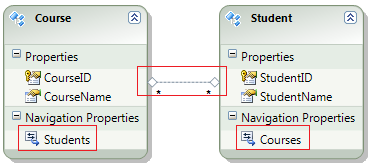Suggested Videos
Part 19 - Table Per Hierarchy (TPH) inheritance in entity framework with code first
Part 20 - Table Per Type (TPT) inheritance in entity framework
Part 21 - Table Per Type (TPT) inheritance in entity framework code first
In this video we will discuss many-to-many relationship in entity framework with database first approach. We will be using the following 3 tables in this demo. There is a Many-to-Many relationship between Courses and Students. A student can enroll into many courses and a single course can have many students enrolled. The data is stored in the StudentCourses bridge table

SQL Script to create the above 3 tables
Now if we generate an ADO.NET entity data model based on the above 3 tables, only 2 entities (Student & Course) are generated with a Many-to-Many association between them. Notice that an entity for the bridge table (StudentCourses) is not generated in the entity model. Also, notice that we have navigation properties to navigate from Course to Students and from Student to Courses.

At this point, right click on Many-to-Many association and select Table Mapping option. In the Mapping Details window notice that, the StudentCourses Many-to-Many association is mapped to StudentCourses database table.

Now, let us see how to query the data. We want to display all the students names and the courses they have opted into.

Drag and drop a GridView control on the webform. Copy and paste the following code in the code-behind file.
Turn on SQL Profiler and load the webform. Notice that the generated SQL Query joins all the 3 tables (Students, Courses & StudentCourses)
Modifying data:
Assign Mike to WCF course
Remove John from SQL Server course
To achieve this,
1. Drag and Drop 2 button controls on the web form
2. Change text on the
First button to Assign WCF Course to Mike
Second button to Remove John from SQL Server Course
3. Copy and paste the following code in the respective click event handler methods
Turn on SQL Profiler and load the webform. Click on the buttons and notice the queries generated.
Query to assign WCF course to Mike
Query to remove John from SQL Server Course

Part 19 - Table Per Hierarchy (TPH) inheritance in entity framework with code first
Part 20 - Table Per Type (TPT) inheritance in entity framework
Part 21 - Table Per Type (TPT) inheritance in entity framework code first
In this video we will discuss many-to-many relationship in entity framework with database first approach. We will be using the following 3 tables in this demo. There is a Many-to-Many relationship between Courses and Students. A student can enroll into many courses and a single course can have many students enrolled. The data is stored in the StudentCourses bridge table

SQL Script to create the above 3 tables
Create Table Courses
(
CourseID int identity primary key,
CourseName nvarchar(50)
)
GO
Create Table Students
(
StudentID int identity primary key,
StudentName nvarchar(50)
)
GO
Create Table StudentCourses
(
StudentID int not null foreign key references Students(StudentID),
CourseID int not null foreign key references Courses(CourseID)
primary key
(StudentID,
CourseID)
)
GO
Insert into Courses values ('C#')
Insert into Courses values ('ASP.NET')
Insert into Courses values ('SQL Server')
Insert into Courses values ('WCF')
GO
Insert into Students values ('Mike')
Insert into Students values ('John')
GO
Insert into StudentCourses values (1, 1)
Insert into StudentCourses values (1, 2)
Insert into StudentCourses values (2, 1)
Insert into StudentCourses values (2, 2)
Insert into StudentCourses values (2, 3)
GO
Now if we generate an ADO.NET entity data model based on the above 3 tables, only 2 entities (Student & Course) are generated with a Many-to-Many association between them. Notice that an entity for the bridge table (StudentCourses) is not generated in the entity model. Also, notice that we have navigation properties to navigate from Course to Students and from Student to Courses.

At this point, right click on Many-to-Many association and select Table Mapping option. In the Mapping Details window notice that, the StudentCourses Many-to-Many association is mapped to StudentCourses database table.

Now, let us see how to query the data. We want to display all the students names and the courses they have opted into.

Drag and drop a GridView control on the webform. Copy and paste the following code in the code-behind file.
protected void Page_Load(object sender, EventArgs
e)
{
EmployeeDBContext employeeDBContext = new EmployeeDBContext();
GridView1.DataSource = from student in
employeeDBContext.Students
from course in student.Courses
select new
{
StudentName = student.StudentName,
CourseName = course.CourseName
};
GridView1.DataBind();
}
Turn on SQL Profiler and load the webform. Notice that the generated SQL Query joins all the 3 tables (Students, Courses & StudentCourses)
SELECT
[Extent1].[StudentID] AS
[StudentID],
[Extent1].[StudentName] AS
[StudentName],
[Join1].[CourseName] AS
[CourseName]
FROM [dbo].[Students]
AS [Extent1]
INNER JOIN (SELECT [Extent2].[StudentID]
AS [StudentID],
[Extent3].[CourseName] AS
[CourseName]
FROM [dbo].[StudentCourses]
AS [Extent2]
INNER JOIN [dbo].[Courses] AS [Extent3]
ON [Extent3].[CourseID] =
[Extent2].[CourseID] )
AS [Join1] ON [Extent1].[StudentID]
= [Join1].[StudentID]
Modifying data:
Assign Mike to WCF course
Remove John from SQL Server course
To achieve this,
1. Drag and Drop 2 button controls on the web form
2. Change text on the
First button to Assign WCF Course to Mike
Second button to Remove John from SQL Server Course
3. Copy and paste the following code in the respective click event handler methods
protected void Button1_Click(object sender, EventArgs
e)
{
EmployeeDBContext employeeDBContext = new EmployeeDBContext();
Course WCFCourse = employeeDBContext.Courses
.FirstOrDefault(x => x.CourseID
== 4);
employeeDBContext.Students.FirstOrDefault(x =>
x.StudentID == 1)
.Courses.Add(WCFCourse);
employeeDBContext.SaveChanges();
}
protected void Button2_Click(object sender, EventArgs
e)
{
EmployeeDBContext employeeDBContext = new EmployeeDBContext();
Course SQLServerCourse = employeeDBContext.Courses
.FirstOrDefault(x => x.CourseID
== 3);
employeeDBContext.Students.FirstOrDefault(x =>
x.StudentID == 2)
.Courses.Remove(SQLServerCourse);
employeeDBContext.SaveChanges();
}
Turn on SQL Profiler and load the webform. Click on the buttons and notice the queries generated.
Query to assign WCF course to Mike
exec sp_executesql N'insert [dbo].[StudentCourses]([StudentID], [CourseID])
values (@0, @1)',N'@0 int,@1 int',@0=1,@1=4
Query to remove John from SQL Server Course
exec sp_executesql N'delete [dbo].[StudentCourses] where
(([StudentID] = @0) and ([CourseID] =
@1))',N'@0 int,@1 int',@0=2,@1=3

I have got this proble why can anyone give answer plz ? Data binding directly to a store query (DbSet, DbQuery, DbSqlQuery, DbRawSqlQuery) is not supported. Instead populate a DbSet with data, for example by calling Load on the DbSet, and then bind to local data. For WPF bind to DbSet.Local. For WinForms bind to DbSet.Local.ToBindingList(). For ASP.NET WebForms you can bind to the result of calling ToList() on the query or use Model Binding, for more information see http://go.microsoft.com/fwlink/?LinkId=389592.
ReplyDeletetry this it will work
ReplyDeleteEmployeeDBContext employeeDBContext = new EmployeeDBContext();
var query = from student in employeeDBContext.Students
from course in student.Courses
select new
{
studentname = student.StudentName,
CourseName = course.CourseName
};
GridView1.DataSource = query.ToList();
GridView1.DataBind();
or only add :
Deletefrom student in employeeDBContext.Students.ToList()
from course in student.Courses.ToList()
store query in var
ReplyDeleteand call with gridview
Violation of PRIMARY KEY constraint 'PK__StudentC__5E57FD6107020F21'. Cannot insert duplicate key in object 'dbo.StudentCourses'.
ReplyDeleteThe statement has been terminated.